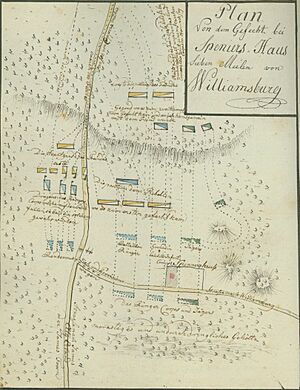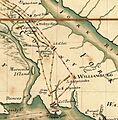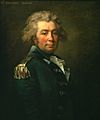Battle of Spencer's Ordinary facts for kids
Quick facts for kids Battle of Spencer's Ordinary |
|||||||
|---|---|---|---|---|---|---|---|
| Part of the American Revolutionary War | |||||||
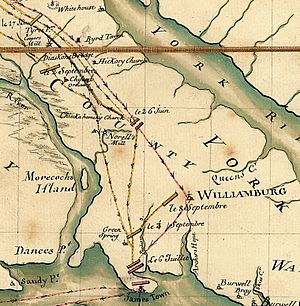 This map from 1781 shows where Lafayette and Cornwallis moved their armies. The fight at Spencer's is marked "le 26 Juin" (June 26). |
|||||||
|
|||||||
| Belligerents | |||||||
| Commanders and leaders | |||||||
| Richard Butler | John Graves Simcoe | ||||||
| Strength | |||||||
| 570 | 400 | ||||||
| Casualties and losses | |||||||
| 9 killed 14 wounded 32 captured |
11 killed 25 wounded |
||||||
The Battle of Spencer's Ordinary was a small fight that didn't have a clear winner. It happened on June 26, 1781, during the American Revolutionary War. British forces, led by Lieutenant Colonel John Graves Simcoe, fought American forces, led by Colonel Richard Butler. These were smaller groups from the main armies of General Lord Cornwallis and the Marquis de Lafayette. They met near a tavern called Spencer's Ordinary, close to Williamsburg, Virginia.
Lafayette had been following Cornwallis's army as it moved towards Williamsburg. When Lafayette learned that Simcoe's group was separated from Cornwallis, he sent Butler to try and stop them. Both sides were worried that the other's main army might arrive. Because of this, they both decided to stop fighting and pull back.
Why the Battle Happened
In May 1781, Lord Charles Cornwallis arrived in Petersburg, Virginia. He had been fighting in North and South Carolina. Cornwallis took command of about 5,000 soldiers. He also got 2,000 more troops from New York. These British forces were much larger than the American army led by the Marquis de Lafayette, who was in Richmond.
Cornwallis wanted to stop Virginia from helping the American Revolution. He chased Lafayette's army, which had only about 3,000 soldiers, many of whom were new to fighting. Lafayette managed to avoid a big battle with Cornwallis for about a month. Cornwallis used his larger army to send groups to attack important places in Virginia.
Lafayette's army grew to about 4,000 soldiers. He got more experienced soldiers from General Anthony Wayne and William Campbell. With more troops, Lafayette became bolder. He sent out his own groups to counter Cornwallis's raids. These groups included cavalry (soldiers on horseback) and infantry (soldiers on foot).
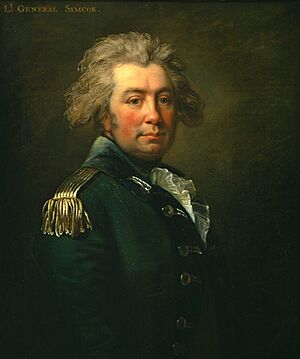
Lafayette wanted to fight parts of Cornwallis's army without facing all of it. As Cornwallis moved towards Williamsburg, Lafayette heard that Lieutenant Colonel John Graves Simcoe and his Loyalist regiment, the Queen's Rangers, were returning from a raid. Simcoe's group also included some Hessian jägers. These were German soldiers known for their skill in skirmishes.
On the night of June 25, General Wayne sent Colonel Richard Butler to stop Simcoe's force. Butler's advance group, about 100 soldiers, met Simcoe's advance companies near Spencer's Ordinary. This was a tavern about 6 miles (10 km) north of Williamsburg.
The Fight at Spencer's Ordinary
Simcoe's troops were moving towards Williamsburg. They were bringing cattle with them. The infantry and jägers were in front, with Simcoe and the cavalry about an hour behind. At Spencer's Ordinary, everyone met up and stopped to rest. Simcoe ordered nearby fences to be taken down. He thought it was a good spot for "clever fighting."
While resting, some Loyalists went to find more cattle. The cavalry went to a nearby farm to feed their horses. McPherson's American soldiers found the cavalry. The British sentries quickly raised the alarm. Simcoe's cavalry then charged McPherson's group, breaking them apart. Several Americans were captured.
As Butler's main force started to arrive, Simcoe sent most of his infantry to help his cavalry. He also sent the jägers and light infantry into the woods to attack the American column from the side. Simcoe learned from the prisoners that Lafayette was close by. He sent a message to Cornwallis. He also sent the cattle convoy towards Williamsburg. Then, he ordered trees to be cut down to build a barricade across the road.
Simcoe arranged his troops to make it look like there were more soldiers just over a hill. When Butler's force arrived, Simcoe ordered his infantry to charge. This scattered the first American soldiers into the woods, where the jägers pushed them back. But Butler's men kept moving forward. Simcoe then ordered a cavalry charge and fired a cannon. This made it seem like a much larger force was arriving. The charge pushed Butler's men back. At this point, both sides stopped fighting. Simcoe pulled back because he thought Lafayette was coming. Butler pulled back because he was tricked by Simcoe's clever plan.
What Happened Next
Simcoe left his wounded soldiers at the tavern under a truce flag. He then pulled back down the Williamsburg road. He met up with Cornwallis's soldiers about two miles (3.2 km) away. The Americans went back to Lafayette's camp. Simcoe was later able to return to the tavern and get his wounded soldiers.
Simcoe reported that his side had 11 killed and 25 wounded. He said the Americans had 9 killed, 14 wounded, and 32 captured. Lafayette claimed the Americans had killed 60 and wounded 100 British soldiers. Cornwallis claimed the British had 33 killed and wounded.
Today, the battle location is part of Freedom Park in James City County, Williamsburg.
Images for kids
-
Portrait of John Graves Simcoe in uniform of the Queen's Rangers Jean Laurent Mosnier, 1791


